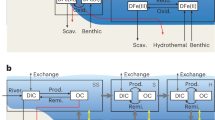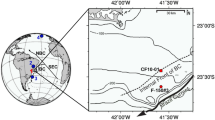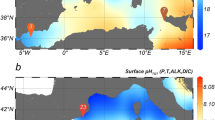Abstract
Today, over 90% of all organic carbon burial in the ocean occurs in continental margin sediments1. This burial is intrinsically linked to the cycling of biogeochemically important elements (such as N, P, S, Fe and Mn) and, on geological timescales, largely controls the oxygen content of the atmosphere2,3,4. Currently there is a volatile debate over which processes govern sedimentary organic carbon preservation5,6,7,8. In spite of numerous studies demonstrating empirical relationships between organic carbon burial and such factors as primary productivity9, the flux of organic carbon through the water column10, sedimentation rate11,12, organic carbon degradation rate13, and bottom-water oxygen concentration8,14, the mechanisms directly controlling sedimentary organic carbon preservation remain unclear. Furthermore, as organic carbon burial is the process that, along with pyrite burial15, balances O2 concentrations in the atmosphere, it is desirable that any mechanism proposed to control organic carbon preservation include a feedback buffering atmospheric oxygen concentrations over geological time. Here we compare analyses of sediments underlying two regions of the eastern North Pacific Ocean, one which has oxygen-depleted bottom waters and one with typical oxygen distributions. Organic carbon burial efficiency is strongly correlated with the length of time accumulating particles are exposed to molecular oxygen in sediment pore waters. Oxygen exposure time effectively incorporates other proposed environmental variables8,9,10,11,12,13,14, and may exert a direct control on sedimentary organic carbon preservation and atmospheric oxygen concentrations.
This is a preview of subscription content, access via your institution
Access options
Subscribe to this journal
Receive 51 print issues and online access
$199.00 per year
only $3.90 per issue
Buy this article
- Purchase on Springer Link
- Instant access to full article PDF
Prices may be subject to local taxes which are calculated during checkout


Similar content being viewed by others
References
Hedges, J. I. & Keil, R. G. Sedimentary organic matter preservation: an assessment and speculative synthesis. Mar. Chem. 49, 81–115 (1995).
Berner, R. A. Burial of organic carbon and pyrite sulfur in the modern ocean: Its geochemical and environmental significance. Am. J. Sci. 282, 451–473 (1982).
Hedges, J. I. Global biogeochemical cycles: progress and problems. Mar. Chem. 39, 67–93 (1992).
Holland, H. D. The Chemistry of the Atmosphere and Oceans (Wiley, New York, 1978).
Canfield, D. E. Sulfate reduction and oxic respiration in marine sediments: implications for organic carbon preservation in euxinic environments. Deep-Sea Res. 36, 121–138 (1989).
Henrichs, S. M. Early diagenesis of organic matter in marine sediments: progress and perplexity. Mar. Chem. 39, 119–149 (1992).
Pedersen, T. F., Shimmield, G. B. & Price, N. B. Lack of enhanced preservation of organic matter in sediments under the oxygen minimum on the Oman margin. Geochim. Cosomochim. Acta. 56, 545–551 (1992).
Paropkari, A. L., Prakash Babu, C. & Mascarenhas, A. Acritical evaluation of depositional parameters controlling the variability of organic carbon in Arabian Sea sediments. Mar. Geol. 107, 213–226 (1992).
Calvert, S. E. & Pedersen, T. F. in Productivity, Accumulation and Preservation of Organic Matter in Recent and Ancient Sediments (eds Whelan, J. K. & Farrington, J. W.) 231–263 (Columbia Univ. Press, New York, 1992).
Jahnke, R. A. Early diagnesis and recycling of biogenic debris at the seafloor, Santa Monica Basin, California. J. Mar. Res. 48, 413–436 (1990).
Müller, P. J. & Suess, E. Productivity, sedimentation rate, and sedimentary organic matter in the oceans — I. Organic carbon preservation. Deep-Sea Res. A 26, 1347–1362 (1979).
Betts, J. N. & Holland, H. D. The oxygen content of ocean bottom waters, the burial efficiency of organic carbon, and the regulation of atmospheric oxygen. Paleogeogr. Paleoclim. Paleoecol. 97, 5–18 (1991).
Emerson, S. in The Carbon Cycle and Atmospheric CO2: Natural Variations Archaean to Present (eds Sundquist, T. & Broecker, W. S.) 78–87 (Am. Geophys. Union, Washington DC, 1985).
Demaison, G. J. & Moore, G. T. Anoxic environments and oil source bed genesis. Org. Geochem. 2, 9–31 (1980).
Berner, R. A. & Canfield, D. E. Anew model for atmospheric oxygen over phanerozoic time. Am. J. Sci. 289, 333–361 (1989).
Henrichs, S. M. & Reeburgh, W. S. Anaerobic mineralization of marine sediment organic matter: Rates and the role of anaerobic processes in the oceanic carbon economy. Geomicrobiol. J. 5, 191–237 (1987).
Reimers, C. E., Jahnke, R. A. & McCorkle, D. C. Carbon fluxes and burial rates over the continental slope and rise off central California with implications for the global carbon cycle. Glob. Biogeochem. Cycles 6, 199–224 (1992).
Carpenter, R., Bennet, J. T. & Peterson, M. L. 210Pb activities in and fluxes to sediments of the Washington continental slope and shelf. Geochim. Cosomochim. Acta. 45, 1155–1172 (1981).
Devol, A. H. & Christensen, J. P. Benthic fluxes and nitrogen cycling in sediments of the continental margin of the eastern North Pacific. J. Mar. Res. 51, 345–372 (1993).
Bevington, P. R. & Robinson, D. K. Data Reduction and Error Analysis for the Physical Sciences (McGraw-Hill, New York, 1992).
Jahnke, R. A., Emerson, S. R. & Murray, J. W. Amodel of oxygen reduction, denitrification and organic matter remineralization in marine sediments. Limnol. Oceanogr. 27, 610–623 (1982).
Martin, W. R., Bender, M., Leinen, M. & Orchardo, J. Benthic organic carbon degradation and biogenic silica dissolution in the central equatorial Pacific. Deep-Sea Res. 38, 1481–1516 (1991).
Archer, D. & Devol, A. H. Benthic oxygen fluxes on the Washington shelf and slope: A comparison of in situ microelectrode and chamber flux measurements. Limnol. Oceanogr. 37, 614–629 (1992).
Lehrman, A. Geochemical Processes: Water and Sediment Environments (Wiley & Sons, New York, 1979).
Calvert, S. E., Bustin, R. M. & Pedersen, T. F. Lack of evidence for enhanced preservation of sedimentary organic matter in the oxygen minimum of the Gulf of California. Geology 20, 757–760 (1992).
26. Keil, R. G., Hu, F. S., Tsamakis, E. C. & Hedges, J. I. Pollen in marine sediments as an indicator of oxidation of organic matter. Nature 369, 639–641 (1994).
27. Cowie, G. L. & Hedges, J. I. Biochemical indicators of diagenetic alteration in natural organic matter mixtures. Nature 369, 304–307 (1994).
Acknowledgements
We thank B. Hales and J. Brandes for discussions, and D. Lambourn, E. Tsamakis, C.Thimsen, B. Paul, L. Balistrieri and numerous participants in the U.W. REU program for analytical assistance. This work was supported by NSF grants to A.H.D. and R.G.K.
Author information
Authors and Affiliations
Corresponding author
Rights and permissions
About this article
Cite this article
Hartnett, H., Keil, R., Hedges, J. et al. Influence of oxygen exposure time on organic carbon preservation in continental margin sediments. Nature 391, 572–575 (1998). https://doi.org/10.1038/35351
Received:
Accepted:
Issue Date:
DOI: https://doi.org/10.1038/35351
This article is cited by
-
Composition and vertical distribution of organic matter in Central Indian Ocean sediment cores
Scientific Reports (2024)
-
Substantial role of check dams in sediment trapping and carbon sequestration on the Chinese Loess Plateau
Communications Earth & Environment (2023)
-
Mineral evolution facilitated Earth’s oxidation
Communications Earth & Environment (2023)
-
A generic hierarchical model of organic matter degradation and preservation in aquatic systems
Communications Earth & Environment (2023)
-
Neogene burial of organic carbon in the global ocean
Nature (2023)
Comments
By submitting a comment you agree to abide by our Terms and Community Guidelines. If you find something abusive or that does not comply with our terms or guidelines please flag it as inappropriate.



